Review: The Lacrimal Gland and Its Role in Dry Eye
- PMID: 27042343
- PMCID: PMC4793137
- DOI: 10.1155/2016/7542929
Review: The Lacrimal Gland and Its Role in Dry Eye
Abstract
The human tear film is a 3-layered coating of the surface of the eye and a loss, or reduction, in any layer of this film may result in a syndrome of blurry vision and burning pain of the eyes known as dry eye. The lacrimal gland and accessory glands provide multiple components to the tear film, most notably the aqueous. Dysfunction of these glands results in the loss of aqueous and other products required in ocular surface maintenance and health resulting in dry eye and the potential for significant surface pathology. In this paper, we have reviewed products of the lacrimal gland, diseases known to affect the gland, and historical and emerging dry eye therapies targeting lacrimal gland dysfunction.
Figures



References
-
- Walcott B. The lacrimal gland and its veil of tears. News in Physiological Sciences. 1998;13(2):97–103. - PubMed
-
- Mausolf F. A. The Anatomy of the Ocular Adnexa; Guide to Orbital Dissection. Springfield, Ill, USA: Thomas; 1975.
Publication types
LinkOut - more resources
Full Text Sources
Other Literature Sources

